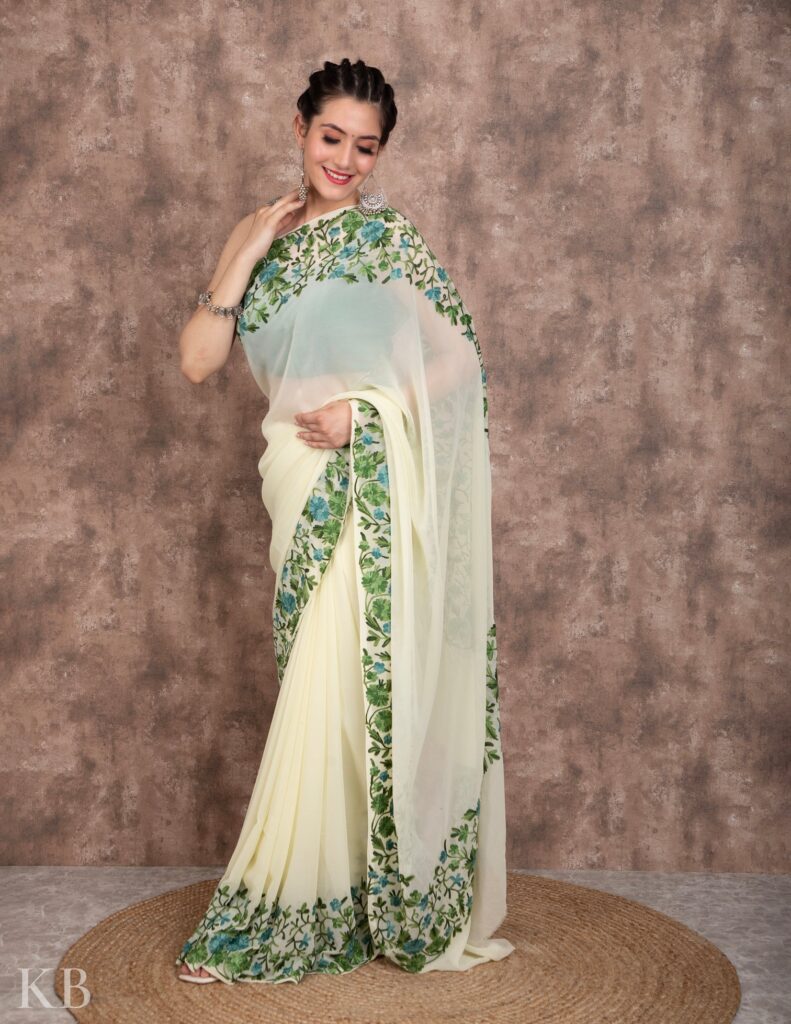Embroidered sarees, exquisite in their craftsmanship and timeless allure, stand as a testament to the rich heritage and artistic finesse of Indian textiles. These sarees, intricately adorned with threads, embellishments, and motifs, are more than just garments; they encapsulate centuries of tradition, culture, and craftsmanship. Let’s delve into the mesmerizing universe of embroidered sarees, exploring their history, diverse styles, craftsmanship, and enduring charm.

A Tapestry of History:
The history of embroidered sarees intertwines with India’s rich cultural legacy. Dating back centuries, embroidery was an art form practiced by skilled artisans, passed down through generations. Each region in India boasts its unique embroidery styles, showcasing the diversity and artistry of Indian textiles.
Craftsmanship and Techniques:
Embroidery on sarees encompasses a plethora of techniques, each requiring precision and skill. From the intricate threadwork of zardozi and chikankari to the vibrant hues of kantha and the dazzling mirror work of Gujarat, each style narrates its story through meticulously woven threads. The use of various stitches, materials, and motifs adds depth and character to the saree, making it a masterpiece of artistry.
Regional Diversity and Styles:
India’s diverse cultural landscape gives rise to an array of embroidered saree styles, each reflecting the heritage and aesthetics of its region. Banarasi sarees from Varanasi boast opulent zari work, while the delicate beauty of Lucknowi chikankari sarees exudes elegance. The vibrant colors and mirror work of Rajasthani sarees and the graceful simplicity of Kerala kasavu sarees showcase the regional richness of embroidery.
Timeless Elegance:
Embroidered sarees epitomize timeless elegance, transcending trends and seasons. Whether it’s for festive occasions, weddings, or everyday wear, these sarees hold an irreplaceable space in every woman’s wardrobe. They effortlessly blend tradition with modernity, offering a sense of grace and sophistication to the wearer.
Artisanal Pride and Heritage:
Behind every embroidered saree lies the dedication and artistry of skilled artisans. Their meticulous craftsmanship, passed down through generations, infuses life into these sarees, preserving cultural heritage and supporting local communities. It’s this artisanal pride that adds an invaluable touch of authenticity to each embroidered masterpiece.
Modern Resurgence:
While rooted in tradition, embroidered sarees continue to evolve with contemporary influences. Designers and artisans experiment with fusion styles, incorporating modern elements while preserving the essence of traditional embroidery. This fusion has propelled embroidered sarees into the global fashion scene, captivating audiences worldwide.
Symbolism and Significance:
Embroidered motifs often carry symbolic meanings, portraying stories, folklore, or cultural significance. From floral patterns symbolizing nature’s beauty to intricate geometric designs representing harmony, these motifs add layers of meaning and depth to the sarees, making them more than just clothing but a form of art.
Celebrating Heritage and Identity:
Adorning an embroidered saree is not just about wearing a garment; it’s about embracing culture, celebrating heritage, and expressing identity. Each saree, with its unique embroidery style, becomes a canvas that reflects the wearer’s personality and connects them to their roots.
Embroidered sarees stand as a testament to the timeless allure of Indian textiles, preserving centuries-old craftsmanship and cultural narratives. Beyond being mere clothing, they represent a heritage woven in threads, carrying stories of tradition, artistry, and regional diversity. As we embrace the beauty of embroidered sarees, let’s honor the skilled artisans and the legacy they weave into each delicate stitch, ensuring that this artistry continues to enchant generations to come.
